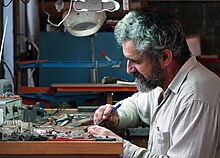| Lise | |
|---|---|
 At work in 2006. At work in 2006. | |
| Born | Eliseo Nicolás Alonso (1955-02-15)15 February 1955 Agones, Pravia, Spain |
| Died | 2 June 2012(2012-06-02) (aged 57) Pereda, Grado, Asturias, Spain |
| Nationality | Spanish |
| Education | Self-taught |
| Known for | Woodcarving, sculpting jet (lignite) |
Eliseo Nicolás Alonso (Agones, Pravia, 15 February 1955 - Pereda, Grado, Asturias, 2 June 2012) was an Asturian artisan who was known as Lise and mainly by his work with jet. He was a sculptor and woodcarver.
Biography

Eliseo Nicolás Alonso was born in Pravia and lived with his family in the school-house of Reconco. He was an artisan who could be considered an artist. His workshop was in the lower level of his home.
He was trained as a General Basic Education Teacher, but did not practice. He had an early inclination for the plastic arts. Lise was self-taught, and first used clay and wood as the materials to study forms. His first exposition for wood carving was in 1973.
Work
| This section does not cite any sources. Please help improve this section by adding citations to reliable sources. Unsourced material may be challenged and removed. (March 2019) (Learn how and when to remove this message) |

The need to find large pieces of jet, and the unavailability of the gem, made him inquire about mixtures, taraceas, and other materials such as fine woods, gold, silver, ivory, etc. chosen by considering their colors and hues, as well as their hardness, all to be compatible with the main material of choice which was jet.
Of his first works as a woodcarver, the technique displayed on the staff from the Spanish municipality, the Ayuntamiento de Candamo is worth noting, as well as his carving at the Capilla de Dolores in Grado, with its bells made of jet.
Later, he became recognized because of his new techniques which included work embedding, pouring or combining materials which included fine woods and ivory. Prior to his work, the work done on jet was limited to carving and embellishing with precious metals. Of his notable works in jet, the piece "San Miguel de Lillo" reflects the pre-Roman Asturias.
References
- Monte Carreño, Valentín; Oficioyarte No.21 (p.20): "Adiós a un gran azabachero"
- La Nueva España Arias. S, May 22, 2014: "La villa moscona inaugurará el 1 de junio la plaza dedicada a Eliseo Nicolás, "Lise"" Accessed May 2nd., 2016.
- Fernández, G. A., El Eco de Grado (p.14) – Boletín Municipal (D.L.:AS-1509-92) Ilmo. Ayuntamiento de Grado; December 30, 1996: "La veta moscona del azabache" Accessed May 9, 2016
Bibliography
- In children's literature, the 2002 novel: "Caracoles, Pendientes y Mariposas" (meaning: "snails, slopes and butterflies") won the award: “XIII Premio Ala Delta de la Editorial Edelvives 2002”, and who the author is Blanca Álvarez. Supposedly Eliseo Nicolás Alonso, Lise, is the novelized protagonist. ISBN 84-263-4908-0.
- Text quoted and images included in: "Azabacheria Asturiana". Carreño, Valentín Monte. ISBN 84-606-2668-7 (1995). (Pages: 89, 117, 124 & 133).
- Text quoted and images included in: "El Azabache, Piedra Mágica, Joya, Emblema Jacobeo". Carreño, Valentín Monte. ISBN 84-933551-0-0 (2004). (Pages: 2-173-174).
- "El Castillo de Curiel y su territorio". Menéndez, Andrea Menéndez. ISBN 84-89880-77-8 (2003). (Page: 269).
External links
- Museum Eliseo Nicolás Alonso, “Lise" Museo de Eliseo Nicolás Alonso, “Lise" (in Spanish)